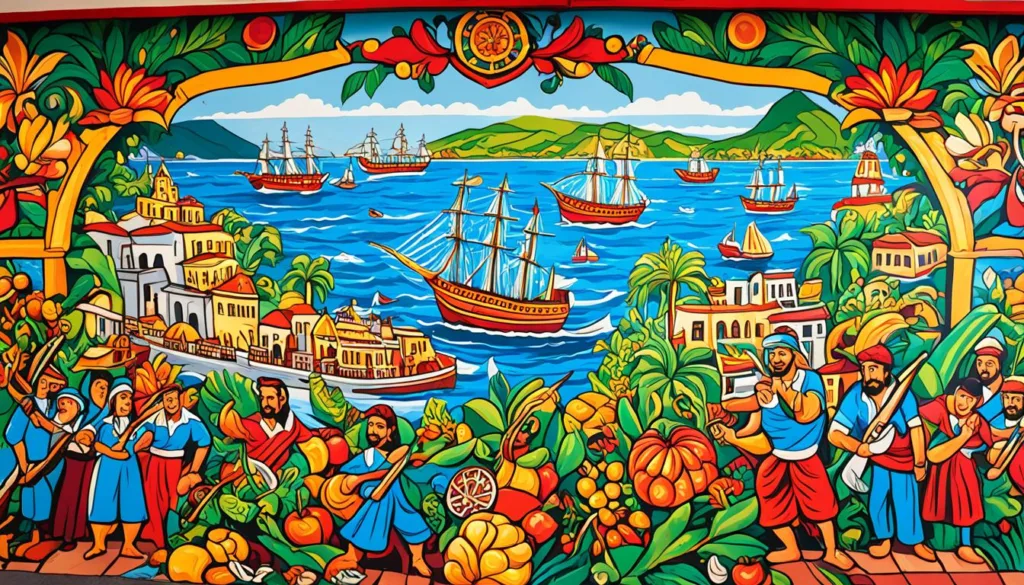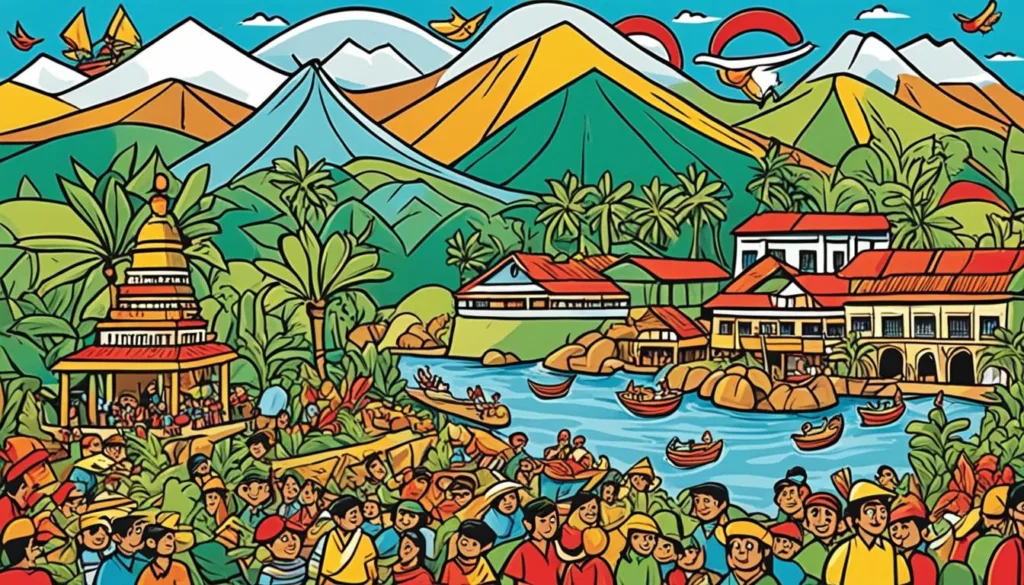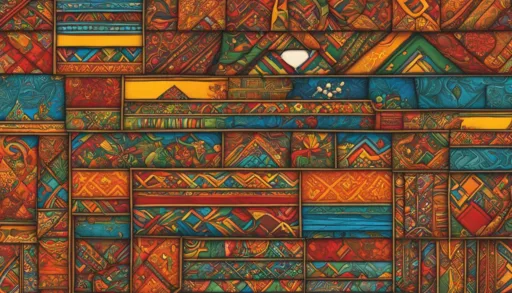In the small Southeast Asian nation of Timor-Leste, no fewer than 20 distinct languages are woven throughout its communities, serving as a testament to an extraordinary mosaic of cultures. Nestled between the exponential biodiversity of the Coral Triangle and the bustle of Maritime Southeast Asia, this linguistic diversity is as vibrant and complex as the surrounding seas. The predominant lingua franca and national language of this geographically modest but culturally rich country is Tetum, an Austronesian tongue with significant Portuguese influence. Alongside Portuguese, its co-official language, Timor-Leste showcases a profound commitment to multilingualism. This remarkable juxtaposition of languages is illustrative of Timor-Leste’s multifaceted history and present-day identity, marking it as an epicenter of linguistic variety in the region and highlighting the extraordinary range of languages spoken Timor-Leste, the preservation of Timorese languages, and the celebration of Timor-Leste linguistic diversity.
Key Takeaways
- Timor-Leste is a living mosaic of cultures reflected in its more than 20 indigenous languages.
- Tetum and Portuguese represent the nation’s commitment to a multilingual identity.
- Linguistic diversity is a pillar of the national identity and cultural richness of Timor-Leste.
- Despite its small size, Timor-Leste plays a significant role in the linguistic landscape of Southeast Asia.
- Understanding the languages of Timor-Leste is key to appreciating its complex history and contemporary society.
- Initiatives to support the variety of languages spoken are crucial for the preservation of Timor-Leste’s heritage.
An Overview of Timor-Leste’s Linguistic Landscape
The rich tapestry of East Timor languages is a testament to its historical saga and cultural amalgamation. In the realm of official languages, Portuguese and Tetum stand at the forefront, steering the nation’s dialogues and administering its policies. A deeper dig into the heart of Timor-Leste uncovers a wealth of indigenous languages that are not just spoken, but live and breathe the essence of various communities across this island nation.
With approximately 16 indigenous languages, the language diversity in Timor-Leste is indeed a cultural bedrock. Preserving the legacy of their regions, languages like Uab Meto radiate through the Oecusse exclave, whereas the eastern territories echo with the cadences of Fataluku. These regional lingos serve as more than mere communication tools; they are identity markers for the ethnic groups that speak them.
Foreign languages have seeped into the linguistic framework as well, with English and Indonesian playing critical roles as lingua francas. This reflects not only historical connections but also the demands of modern communication. In a similar vein, the deaf community finds voice through its own mediums, like the Tetum Sign Language and Indonesian Sign Language.
The shadows of a colonial past are evident in daily interactions, as the Portuguese QWERTY keyboard layout remains prevalent, symbolizing the persistent impact of Portuguese influence in Timorese society. The academic vigor to decode and document this dense linguistic mosaic brings untold stories to the forefront, enhancing global comprehension of Timor-Leste’s language diversity.
Let us unfold the layers of this diverse linguistic realm with a clear portrayal of the language dynamics:
| Language Category | Language Examples | Usage Context |
|---|---|---|
| Official Languages | Portuguese, Tetum | National policy, Education |
| Indigenous Languages | Uab Meto, Fataluku | Regional communication, Cultural identity |
| Foreign Languages | English, Indonesian | Business, Civil Services |
| Sign Languages | Tetum Sign Language, Indonesian Sign Language | Communication for the Deaf Community |
| Colonial Influence | Portuguese QWERTY layout | Technology, Documentation |
As we traverse through the linguistic landscape of this sovereign state, we discover a symphony of dialects and a chorus of cultures, each playing a pivotal role in the symphony that is Timor-Leste’s identity. Capturing this remarkable variety, scholars and linguists continue to unveil the deep-rooted connections of language to heritage and community in Timor-Leste.
Languages Spoken in Timor-Leste: A Dive into Diversity
The linguistic framework of Timor-Leste is as intricate and colorful as its history. With a blend of languages that showcase the nation’s evolution through time, the linguistic diversity of Timor-Leste is a testament to its cultural wealth. This section takes a closer look at the official languages, recognized native tongues, as well as foreign influences shaping the communicative tapestry of this Southeast Asian nation.
Official Languages: Portuguese and Tetum
In the heart of Timor-Leste’s linguistic identity, the official languages play a pivotal role. Portuguese and Tetum, each with its unique cultural significance, are not only mediums of day-to-day communication but also anchors of national unity. Tetum, enriched by its Portuguese history, serves as a common thread for the different ethno-linguistic groups within the country.
Recognized Indigenous Tongues
Complementing the official languages are the Timor-Leste native tongues, which include over 30 indigenous languages. Each language acts as a voice for the distinctive cultural narratives of the island’s ethnic communities, preserving a rich linguistic and cultural tapestry that spans centuries. Among these are prominent languages such as Fataluku, Mambai, and Kemak, which resonate with the island’s deep cultural roots.
Foreign Influences: English and Indonesian
Timor-Leste’s language diversity is further influenced by global and regional interactions, with English and Indonesian emerging as significant languages within the civil service and educational domains. These tongues reflect a pragmatic approach to communication, providing vital links to international and regional partners while navigating the complexities of their historical connotations in Timorese society.
Here is a glimpse of the richness of the linguistic landscape in Timor-Leste:
| Linguistic Category | Examples | Role in Society |
|---|---|---|
| Official Languages | Portuguese, Tetum | National identity, unity, education |
| Indigenous Tongues | Fataluku, Mambai, Kemak | Cultural expression, ethnic diversity |
| Foreign Influences | English, Indonesian | International and regional integration, civil service communication |
To truly appreciate the linguistic fabric of Timor-Leste, one must recognize the harmony and complexity offered by its wide array of languages. The official languages of Timor-Leste, alongside its vibrant native tongues and language diversity, form a unique lexicon that shapes the nation’s past, present, and future.
The Historical Path of Tetum: From Lingua Franca to Official Status
The Tetum language’s journey to attaining Tetum official status is a narrative marked by the colonial past and the fervor of Timorese independence. Initially nurtured through centuries of exchange during Portuguese colonization, Tetum transformed, absorbing elements to become a unifier among the diverse ethnic communities of Timor-Leste.
As an embodiment of national spirit, Tetum’s infusion into all walks of Timorese life—especially in Tetum media education—underscores its importance in shaping the nation’s future.
Colonial Influences and the Portuguese Legacy
Under Portuguese rule, Tetum began its assimilation of European linguistic traits, enriching its vocabulary and grammar. This cross-pollination led to the emergence of a distinct dialect known as Tetun-Portu—key to the lingua franca status it ultimately achieved among the locals.
Tetum’s Role in the Independence Movement
In the throes of resistance against Indonesian occupation, Tetum emerged as a symbol of unity and defiance. Leaders like Xanana Gusmão adeptly wove Tetum into freedom calls, cementing its role in the hearts and minds of the citizens as the voice of a collective struggle toward sovereignty.
Modern Tetum: Usage in Media and Education
Today, Tetum’s vibrancy is evident in various media outlets and educational resources, reflecting concerted efforts to maintain and promote its usage. Expanding Tetum’s presence within these domains serves not only as cultural preservation but also ensures that it remains an integral facet of the nation’s evolving identity.
- Tetum’s growth within local media platforms showcases its adaptability and appeal to a broad audience.
- Investments in Tetum-centric curriculum development emphasize the government’s commitment to a bilingual education system, with Tetum at its core.
The Significance of Portuguese in Timor-Leste
The role of Portuguese in Timor-Leste has been crucial in the country’s history and continues to draw significant attention in the face of evolving national identity. The Portuguese legacy in Timor-Leste is evident not merely as a historical figment but as a living, dynamic cultural force that stands as testimony to the complex facets of colonization and national renewal. In this regard, the language’s adoption as an official language was not only a political decision but a nod to preserving a unique sociohistorical link. However, the road to integrating Portuguese has encountered cultural and educational speed bumps. These challenges hint at the broader dialogue about the nation’s linguistic journey from being a Timor-Leste colonial language to a symbol of unity and distinction within a global context.

As the language that once unified diverse resistance groups against Indonesian occupation, Portuguese offered the East Timorese a voice that resonated with international allies such as Sérgio Vieira de Mello, the late UN administrator. His support underlined the strategic importance of Portuguese amid the political and social upheavals of the time. The shifts in contemporary attitudes toward Portuguese in Timor-Leste are marked by differing generational values and perspectives—where some individuals might reflect on its role with a certain colonial detachment, others advocate for its continued relevance as an integral element of Timor-Leste’s linguistic mosaic.
Despite varying opinions, the imprint of Portuguese is undeniable in the nuances of Timorese society. For instance, educational assistance from Portuguese-speaking nations like Portugal and Brazil has markedly influenced the language’s standing in the educational arena. Yet, it’s not uncommon to hear concerns over the degree of integration achieved so far and the distance yet to be covered. Balancing respect for the past with the educational needs of a growing youth demographic is just one of the perennial challenges inherent in the ongoing discourse around the importance of the Portuguese language in the formative landscape of Timor-Leste.
Portuguese is not just a language spoken in Timor-Leste; it’s part of our shared history and identity. It connects us not just across our own land, but also to the wider Portuguese-speaking world.
Ultimately, the trajectory of Portuguese in Timor-Leste will continue to pivot on how well it resonates with the people’s sense of cultural and national integrity, as well as its ability to coalesce into the larger narrative of Timor-Leste’s ambitions and identity on the world stage.
Indigenous Languages of Timor-Leste: A Cultural Tapestry
The intricate fabric of Timor-Leste’s heritage is interwoven with the diverse linguistic threads of its indigenous languages. These tongues, integral to the nation’s identity, face the perils of global change, but also the promise of revitalization.
Major Indigenous Languages by Number of Speakers
The linguistic landscape of Timor-Leste is marked by a number of indigenous languages that form the crux of its cultural diversity. With varying numbers of speakers, each language holds a mirror to the intricate ethnic mosaic of the region.
| Language | Number of Speakers | Geographical Distribution |
|---|---|---|
| Tetun Prasa | 500,000+ | Mainly in Dili and surrounding areas |
| Mambai | 130,000+ | Central mountains |
| Makasae | 70,000+ | Eastern Timor |
| Kemak | 60,000+ | North-central border regions |
The Preservation and Promotion of Native Tongues
Efforts to cherish and enhance these indigenous languages of Timor-Leste are underway. Initiatives focusing on linguistic preservation Timor-Leste aim to celebrate and cultivate the country’s rich linguistic roots for future generations.
Endangered Languages: The Fight Against Linguistic Extinction
In the midst of globalization, several native languages find themselves teetering on the brink of oblivion. The term endangered languages Timor-Leste reflects not just a potential loss of communication but of cultural identity and history. The dedication to halting this decline is palpable, with researchers and communities alike banding together to uphold the linguistic diversity that underpins the nation’s ethos.
English and Indonesian: The Practicalities of Working Languages in Timor-Leste
Within the sociolinguistic landscape of Timor-Leste, the roles of English and Indonesian are firmly entrenched as practical working languages. This unique linguistic situation is especially noteworthy given the historical intricacies and Timor-Leste’s foreign language influence. English, globally recognized as the language of international diplomacy and business, facilitates Timor-Leste’s educational and economic engagement with the wider world. Alternatively, Indonesian, with its layers of historic complexity, persists within the functional realities of daily life and government operation.
Despite their practical applications, these languages also highlight the generational shifts and the diverse attitudes towards the nation’s evolving identity. English and Indonesian as working languages in Timor-Leste are vital gears in the machinery of this young nation’s development, and their use is illustrative of a pragmatic, forward-thinking perspective that seeks to balance the past while navigating a globalized future.

The appropriation of English and Indonesian as working languages in Timor-Leste underscores a key facet of the country’s adaptability in meeting the demands of an interconnected global environment. While differing viewpoints on linguistic identity persist, the practical embrace of these languages is central to Timor-Leste’s pursuit of international collaboration and domestic cohesion.
Linguistic Diversity in Education and Government Policy
At the heart of Timor-Leste’s cultural fabric lies a profound commitment to linguistic diversity, manifesting most prominently in the realms of education and governmental structures. A deep dive into the nation’s educational system and policy-making illustrates a deliberate effort to create an inclusive, multilingual environment, with the government of Timor-Leste placing significant emphasis on language’s role in national identity and unity.
Language of Instruction in Timorese Schools
The Timor-Leste language education framework integrates multiple languages at different educational levels. Primary education predominantly operates in Tetum, ensuring that children are rooted in the national lingua franca from an early age. Additionally, there is an ascent in the usage of Portuguese, reflecting the government’s stance on fostering bilingual proficiencies among the younger generations.
Governmental Language Policies and their Impact
A pivotal aspect of preserving linguistic diversity is the government language policy Timor-Leste enforces. Through policies that confer official status on Portuguese and Tetum, the administration guarantees the continual use and development of both languages in official capacities. Indigenous languages also receive recognition and support, ensuring their continuance and vitality within the cultural tapestry of the nation.
International Support for Language Education Initiatives
Amplifying local efforts, international linguistic support Timor-Leste receives from Portuguese-speaking countries plays a crucial role. The collaboration with these international partners facilitates the enrichment of language education programs and the bolstering of resources necessary for their execution. This global alliance not only elevates the quality of language instruction but also reinforces the importance of embracing Timor-Leste’s linguistic plurality.
| Level of Education | Main Language of Instruction | Secondary Languages Recognized | International Partnerships |
|---|---|---|---|
| Primary Education | Tetum | Portuguese, Local Indigenous Languages | Portugal, Brazil, Others |
| Secondary Education | Portuguese and Tetum | English, Indonesian | Lusophone Education Programs |
| Higher Education | Portuguese | Tetum, English | Academic Exchanges, Scholarships |
Timor-Leste’s multilayered approach to language education, underpinned by government policies and complemented by international support, fosters a nurturing environment where linguistic diversity thrives. It forms a cornerstone for the nation’s cultural preservation, offering a bridge that connects past, present, and future.
The Role of Literacy and Language Proficiency in Socioeconomic Development
To grasp the essence of development in Timor-Leste, one must recognize the fundamental role played by literacy and language proficiency. Improved literacy rates directly correlate with socio-economic advancement, empowering individuals to fully participate in society. Language skills, especially in official and working languages like Tetum, Portuguese, English, and Indonesian, are vital tools for unlocking employment opportunities in Timor-Leste.
Literacy Rates and Language Comprehension
Timor-Leste’s efforts to elevate literacy rates have been pivotal in enhancing language comprehension among its citizens. Young adults, in particular, reap the benefits of these educational advances, with census data indicating notable improvements in literacy within the 15-24 age demographic. This upward trend is crucial for fostering informed and proficient members of the workforce, setting the stage for a thriving economic environment.
Adult Literacy Programs and their Importance
Recognizing the value of lifelong learning, Timor-Leste has invested in adult literacy programs which are essential for embedding language proficiency Timor-Leste-wide. These programs target the acquisition and refinement of language skills, which are indispensable in today’s information-rich climate. Through such initiatives, adults are given the opportunity to enhance their language proficiency, thereby contributing to personal and national growth.
Impact of Linguistic Skills on Employment Opportunities
Language skills unlock doors in Timor-Leste’s labor market, creating employment opportunities for those who possess them. Proficiency in languages, particularly those aligned with the country’s official and business sectors, is highly sought after. This proficiency not only boosts the employability of individuals but also ensures that Timor-Leste remains competitive in the international arena.
| Age Group | Literacy Rate (%) | Language Proficiency | Impact on Employment |
|---|---|---|---|
| 15-24 | 83 | High in Tetum and Indonesian | Eligible for entry-level jobs and vocational training |
| 25-34 | 68 | Moderate in Portuguese and English | Access to mid-level positions and specialized roles |
| 35-44 | 55 | Varies, with trends towards increasing proficiency | Potential for higher management roles and international collaboration |
| 45+ | 41 | Low, with focus on adult literacy improvement | Expanded job opportunities through upskilling programs |

The Linguistic Future of Timor-Leste: Challenges and Opportunities
As Timor-Leste stands on the brink of its future, the country’s linguistic trajectory presents both unique challenges and ample opportunities. The language challenges the nation faces are multifold; strategies to promote the coexistence of the national languages, Tetum and Portuguese, with more than 30 indigenous languages must be comprehensive and inclusive. Simultaneously, embracing the opportunities to nurture a multilingual society can enhance both cultural richness and unity in diversity.
Timor-Leste’s linguistic future pivots on its ability to adapt to the aspirations of its youth and the inevitable march of globalization. Integrating innovation into education could serve as a catalyst in not merely preserving but energizing Timor-Leste’s linguistic heritage. The foundation of a well-rounded linguistic policy may well become a cornerstone in the nation’s journey toward global participation and economic progress.
| Linguistic Challenge | Opportunity for Growth |
|---|---|
| Integration of Portuguese with local culture | Strengthened cultural ties with Lusophone countries |
| Preservation of indigenous languages | Promotion of cultural identity and diversity |
| Progressing multilingual education | Creation of a dynamic, skilled workforce |
| Managing globalization’s impact | Embracing technological advancements and international collaboration |
| Aligning youth language interests | Cultivating future leaders adept in both local and global contexts |
In essence, the linguistic future of Timor-Leste hinges on policy decisions and education reforms that value linguistic plurality. The canny balance of language challenges with opportunities in Timor-Leste could unlock a future where language acts not as a barrier, but as a bridge to a culturally and economically prosperous society.
Conclusion
The intricate tapestry of Timor-Leste language diversity reflects not just a medley of voices but also tells the story of a land resilient in its quest for cultural coherence. The harmonious existence of Portuguese and Tetum as official languages, reverberating alongside a host of indigenous tongues, stands testament to Timor-Leste’s cultural identity. This linguistic equilibrium is a tightrope walk over the canyon of colonial history and the burgeoning landscape of modern aspirations.
In the face of dynamic linguistic evolution, the populace of Timor-Leste grapples with the dual task of cherishing its linguistic heritage while embracing the unrelenting march of globalization. The young and the old of Timor-Leste seek their reflections within the mosaic of languages, each with varying visions for the days to come. Yet, it is within this intergenerational dialogue that the seeds for a pluralistic and inclusive future are sown.
The fusion of educational strategies, thoughtful governmental policies, and global partnerships underscores the nation’s pledge to preserve its multilingual mosaic. Through collective commitment, Timor-Leste aspires to blend the colors of its linguistic spectrum to create a vibrant portrait of societal progress.
FAQ
What languages are spoken in Timor-Leste?
Timor-Leste hosts a rich linguistic tapestry including two official languages, Portuguese and Tetum, recognized indigenous tongues such as Mambai, Makasae, and Kemak, and foreign languages like English and Indonesian used as working languages.
What are the official languages of Timor-Leste?
The official languages of Timor-Leste are Portuguese and Tetum. These languages are used in government, official communication, and are widely taught in schools.
Are there any indigenous languages recognized by the government?
Yes, Timor-Leste recognizes a number of indigenous languages, and they are spoken in various regions across the nation. Some of these languages include Uab Meto, Fataluku, and many others, contributing to the country’s linguistic diversity.
How have English and Indonesian influenced Timor-Leste’s linguistic landscape?
English is utilized as a practical working language and is associated with globalization and advancement in Timor-Leste, while Indonesian reflects historic connections and is also employed for its practicality within the civil service and education.
How does the Timorese education system accommodate linguistic diversity?
Timorese schools mainly instruct in Tetum, with Portuguese being increasingly present. Indigenous languages are acknowledged and included where possible, demonstrating the government’s commitment to cultivating linguistic wealth.
What role does language proficiency play in socioeconomic development in Timor-Leste?
Language proficiency, particularly in the official and working languages of Timor-Leste, is crucial for improving educational and employment prospects. This, in turn, contributes to the socioeconomic advancement of the nation.
Are there any language preservation initiatives for endangered languages in Timor-Leste?
Timor-Leste actively engages in initiatives to document, safeguard, and revitalize its indigenous languages. These efforts are aimed at preserving the cultural and linguistic identities associated with each native tongue.
How does Portuguese maintain its significance in Timor-Leste despite its colonial past?
Portuguese carries historical and cultural significance for Timor-Leste. Post-independence, it was adopted as an official language to retain a link to the past, and it continues to shape the nation’s identity and linguistic policies.
What are the challenges facing the linguistic future of Timor-Leste?
Timor-Leste’s linguistic challenges include fostering multilingualism, reconciling its colonial past with its present-day needs, and integrating different generations’ linguistic preferences within the educational system and society at large.
What is the role of international support in the development of Timor-Leste’s languages?
International support, particularly from Portuguese-speaking countries, aids in the development and implementation of language education initiatives. These collaborations bolster local efforts to enhance language proficiency and cultural exchange.






